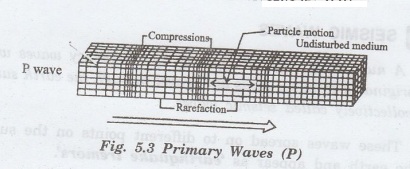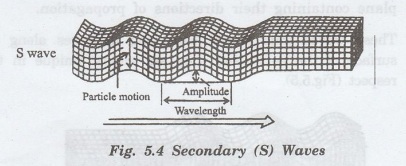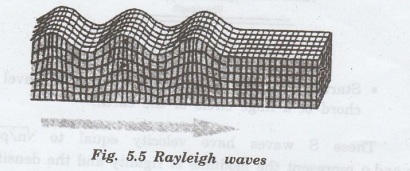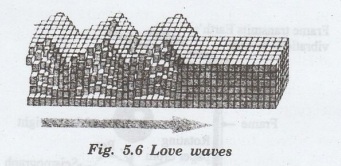Physics For Civil Engineering: Unit V: Natural Disasters
Seismic Waves
Definition, Types | Natural Disasters
A number of different types of low frequency waves which are originated from the focus and travel through the earth surface are collectively called seismic waves.
SEISMIC WAVES
A
number of different types of low frequency waves which are originated from the
focus and travel through the earth surface are collectively called seismic
waves.
These
waves spread on to different points on the surface of the earth and appear as 'earthquake tremors'.
Types
of seismic waves
They consist of '2' different types of
waves: brodo
(i)
Body waves
(ii) Surface waves.
Body
waves
The
waves which travel through the earth are called body waves.
There
are two types of body waves,
(i) Primary (P) or Compressional waves
(ii)
Secondary (S) or Shear waves
The
general pattern of these seismic waves is as shown in
fig. 5.2.

(i) Primary or P Waves
• These are longitudinal waves in
which the particles of the earth vibrate about their mean position along the
direction of the waves themselves. (Fig. 5.3)

•
If the earth is regarded to be a homogeneous sphere, these waves starting from
the focus travel along the chord of huge circle of the earth.
•
The velocity of wave is equal to √E/p, where E is the 'elongational elasticity'
of the earth and p, its density.
•
The velocity is found to be about 5 miles per second.
•
These waves are also called as
'compressional' waves.
(ii) Secondary or S
Waves.
•
These are transverse waves. That is the particles of the earth vibrate at right
angles to the direction of Lasite propagation of the waves. (Fig. 5.4)

•
Starting from the focus, these waves also travel along a chord of a huge circle
of the earth.
These
S waves have velocity equal to √n/p where n and p represent the modulus of
rigidity and the density of the earth respectively.
•
The velocity of S wave is about 3 miles per second.
•
They are also called as 'shear'
waves.
Surface
Waves
The
waves which travel along the earth surface are called surface waves.
These waves can only move along the
surface.
They
also consist of two types of waves,
(i)
Rayleigh waves
(ii)
Love waves
(a) Rayleigh Waves
•
These
waves are found to remain confined to a comparatively thin layer in the close vicinity of
the earth's surface.
•
Unlike the P and S waves, they start from the epicentre 10 asli and arrive at
the observing station along a huge circle of
• The displacement of the particles is
being in the vertical plane containing their directions of propagation.
• These waves thus persist over long
distances along the surface of the earth and they are almost unique in this
respect (Fig.5.5).

• Due to heterogeneous character of
earth, each single wave, starting from the epicentre, gets split up into a
briose number of different sets of waves.
•
Since each set has a different wavelength, velocity etc, they produce a series
of oscillation instead of one single 'kick
or throw' at the observing
station.
(ii) Love Waves
The heterogeneity of the layers of the
earth is also responsible for another type of surface waves, known as Love
waves.
In these waves, the displacement of the
earth is horizontal, but transverse to the direction on their propagation.
• The velocity of these waves is less in
the earth's crust. Immediately after an earthquake, oscillations, corresponding
vloviti to these waves can be detected almost any place on the surface of the
earth (Fig.5.6).

• Unlike P and S waves, these waves get
intermingled with Rayleigh waves to form a somewhat complicate system of waves
• These are called long, L waves, or the main shock. These waves are observed as a long series of oscillations.
Physics For Civil Engineering: Unit V: Natural Disasters : Tag: : Definition, Types | Natural Disasters - Seismic Waves
Related Topics
Related Subjects
Physics for Civil Engineering
PH3201 2021 Regulation | 2nd Semester Civil Dept 2021 Regulation
